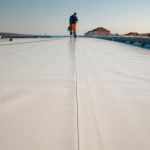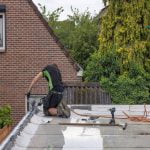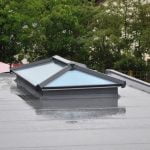What are flat roofs made of in the UK?
If you asked this question twenty years ago, most would say it is felt. Now, in 2021, you have a much wider variety of options when roofing a flat roof.
You can choose from multiple flat roof products, such as modified bitumen, PVC roofing, EPDM, GRP, and more. Each has pros and cons, and they differ in, for example, cost, lifespan, installation complexity, or finish.
It may seem difficult to choose the best flat roof materials, so we have prepared a guide that will help you analyse each solution’s properties and choose the one that best suits your preferences, requirements, and capabilities. Keep reading to find out more about the best flat roof systems!
4 Flat roof types
TYPE 1 Torch-on Felt (Modified Bitumen)
The traditional felt roof covering has been improved with a new technique called torch-on felt (or modified bitumen) to provide more benefits. Previously, this kind of solution was based on pouring mineral felt and hot bitumen onto a roof and rolling it in a flat layer. After this procedure, you were provided with quite an ugly finish and a lifespan of just approximately 10 years. Furthermore, this type of flat roof was often harmed by stones getting under the membrane, which resulted in punctures. As it was not the best flat roofing system, a new technique was applied – in the torch-on felt method, the material can be peeled off and stuck to the surface.
Modified bitumen is a single-ply flat roofing material based on asphalt with special polymers added to boost its flexibility and overall performance. It has a granulated or smooth finish, and it is produced in the form of rolls that can be self-adhesive, hot-applied, or cold-applied. It is installed in a specific layer permutation that compounds to boost the flat roof’s efficiency.
Modified bitumen is a relatively cost-effective flat roofing material due to its short lifespan of 10-20 years. It is reasonably durable and can withstand extreme temperature changes. Apart from that, it can reduce the heat flow on flat roof surfaces. As you can achieve a coherent, seamless connection between the modified bitumen rolls and your flat roof, this system is a great protection against leakage. Also, its materials are environmentally friendly because they can be recycled.
However, although modified bitumen can be installed easily, this process requires using a blow torch to produce extreme heat, which can produce harmful fumes and be a potential fire hazard. Also, for a few days after the installation, you may still be able to smell an unpleasant odour, which is another side effect.
If it is really hot, modified bitumen can slightly melt, creating an uneven surface. Due to its limited lifespan, be prepared for easy but frequent and messy repairs. Moreover, bear in mind that it is very sensitive to heavy foot traffic.
Pros:
- Cost-effectiveness/Low price
- Heat flow-reducing properties
- Easy product installation
- Protection against leakage
- Recyclability
- UV and heat resistance
Cons:
- Short lifespan
- Harmful fumes while being installed
- Unpleasant odour for a few days
- Messy and patchy repairs/Heavy foot traffic sensibility
- The need for regular checks and maintenance
- Hot temperature sensitivity, resulting in a damaged appearance

TYPE 2 GRP (Fibreglass)
GRP (fibreglass) flat roofs are a popular option in the United Kingdom. GRP stands for glass-reinforced plastic, and it is a composite material produced by strengthening plastic with fine glass fibres. Such a single-ply laminate has been used as a flat roof covering for over 60 years now, but it was harder to install in the past. Nowadays, you can buy fibreglass trims that are better adapted as a flat roofing material, and installation is much easier.
GRP is a durable material that can be used for around 25 years. Moreover, it is amazingly flexible, so it can be used not only on flat roofs but also, for example, green or lightweight roofs and those of complex shapes. You can also easily adjust it to your preferences, as many colour variants are available on the market.
If any flaws appear, you can easily repair them yourself without the need to call a professional roofing contractor. However, a new GRP flat roofing system can be pretty expensive and may not be the best for a larger surface. Also, remember that it can be installed only in specific weather conditions because it may be difficult to assemble when it is not dry.
Pros:
- Flexibility/Durability flat roofing material
- A lifespan of around 25 years
- Simple repairs
- Various colours
Cons:
- High price
- Not the best option for a large flat roof
- Installation requiring good weather conditions
TYPE 3 PVC
Polyvinyl chloride (PVC) is a kind of plastic produced due to a gaseous reaction between ethylene, hydrochloric acid, and oxygen. When prepared as one of the flat roof materials, PVC is strengthened with plasticised attributes that help make the surface low maintenance and durable. Apart from flat roofs, such a system can also be applied to conservatories.
Similar to many other flat roof materials, PVC is manufactured in the form of a membrane. Such a piece can be rolled onto the roofing surface and attached to it with either nails or adhesives. As it is resistant to chemicals and fire, it is often used in the roofing systems of various commercial buildings. To mount PVC, it usually needs to be heat-welded at the seams, which is a good thing because it helps seal the weakest areas of a flat roof and keep them watertight. Despite being lightweight, this roofing material is one of the best for durability (lasting around 20 years.)
One of the most significant disadvantages of a PVC roofing system is that it is unable to interact with asphalt in any way. It happens that a flat roof is constructed from a mix of different materials, with hot asphalt added at the top of the membrane. In such a case, it must be separated from PVC, demanding more effort during installation. Moreover, roof replacement requires more effort than other materials. You should also be aware of its toxicity – during the PVC roofing production, such toxins as dioxin emerge, and they can contribute to some health problems.
Pros:
- Chemical and fire resistance
- Watertightness/Longevity
- Suitability for commercial buildings
- Lightweight
Cons:
- Incompatibility with asphalt
- Toxicity
- Roof replacement complications
TYPE 4 EPDM/Rubber
EPDM (ethylene propylene diene monomer) is a type of synthetic rubber that can have many different uses as it is durable and versatile and one of the UK’s most popular options when roofing a flat roof.
Rubber is resistant to extremely high temperatures in general, but EPDM stands out by being able to withstand extreme cold as well. For this reason, and for its insulative properties, it is applied, for instance, in freezers and refrigerators. What is more, it is used in glass-run channels, face masks for industrial respirators, washers, tubing, garden and appliance hoses, electrical insulation, geomembranes, and more. Also, thanks to its flexibility, it is amazingly useful for producing rigid parts, such as shafts, gears, and structural beams.
Apart from all these applications, rubber is probably the best flat roof material you can think of. Many companies appreciate it because of its ability to withstand extreme weather conditions which makes it perfect for commercial and industrial buildings. Moreover, it is also excellent for preventing water from entering your property – it can keep you safe from leakage for many years. Along with that, it also repels algae so you will not have to waste your time removing it again and again. See our shop.
Also, it is the best flat roof material for foot traffic on top of your building. In this way, you will not have to limit access to the roof and let your personnel do their tasks without any concerns. Being durable, it is also lightweight, and it does not add any extra stress to your property, even under extreme weather conditions. You can have an EPDM roof membrane installed at any time of the year and in any climate you like – even if there are great temperature fluctuations, it will remain in good shape.
On top of that, a rubber roofing material can be easily combined with polyiso insulation and is available not only in black but also white. For this reason, it is an energy-efficient product because it reflects the sun, protecting you from the heat in summer, yet helping you keep the warmth inside in the colder days. In this way, you can use less heating or air-conditioning. Furthermore, it may come as a surprise, but when installed and maintained correctly, a new EPDM roofing system can be very long-lasting, with a lifespan reaching as much as 30-50 years.
Regarding disadvantages, it must be said that a rubber membrane is one of the flat roofing systems that may need excellent DIY skills or even professional help if you have no experience. It is crucial to mount an EPDM flat roof covering carefully and precisely because, in this way, you can increase the probability for it to last 50 years.
Also, consider that industrial roofing materials like this type of product are not too decorative – it will not look as good as, say, asphalt or wooden shingles. Nevertheless, it is highly appreciated by companies that often consider it one of the best flat roof materials for a business park.
Pros:
- Flexibility/Longevity
- Sun-reflecting white variant available
- Great insulation properties
- Durability/Foot traffic resistance
- Extreme weather resistance
- Lightweight
- Algae resistance
- Watertightness
Cons:
- Lack of decorativeness
- Precise installation needed
Conclusion
You can cover your new roof with many different material options, such as modified bitumen, fibreglass, or PVC roofing. However, as our guide shows, a rubber roofing membrane is probably the best product of this type that you can get nowadays. It provides many advantages with few drawbacks, so it is highly appreciated by many businesses that need more efficiency and less decorativeness.
If you would like to receive more information on EPDM roofs or flat roof coverings or are ready to ask for a quote, you can get in touch with us anytime. We are a dedicated team that will help you have as durable and efficient roofs as required in your industry. Do not hesitate to give us a call or send us a message! We will provide you with a rubber roof quote as soon as we can.










